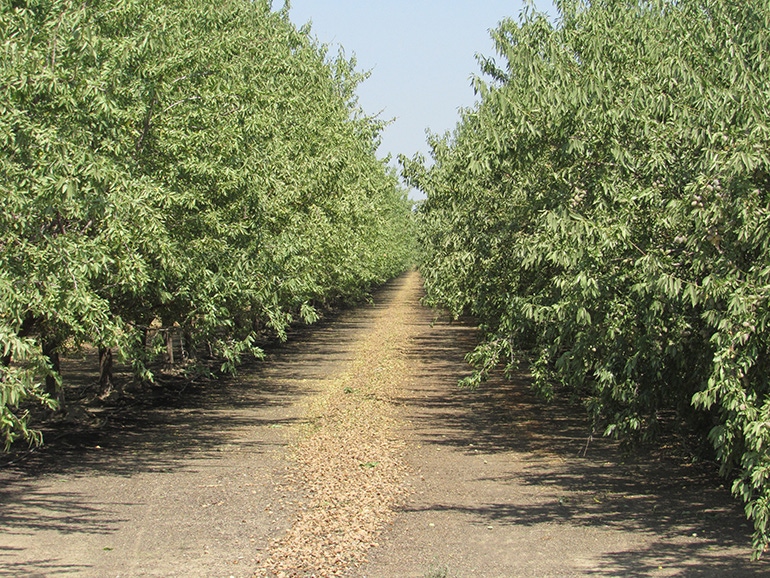
With warmer temperatures dominating the month of July and August, growers across the Central Valley are reporting rapid progress on almond hull split of the nonpareil variety.
Reports last week indicated nonpareil hull split is well underway and even wrapping up in some areas in the southern and central regions of the Valley. With the Independence variety not far behind, some growers are reporting early hull split even on California varieties is beginning, a reminder that harvest, if not already underway, will soon be in full swing.
In Kern County extensive shaking has been reported, a project expected to stretch well into October before the county’s extensive almond acres are completely cleared of fallen nuts.
Overall a late winter season and unexpected weather events will likely result in a slightly smaller harvest this year compared to 2018, but growers have expressed a degree of optimism as near-ideal weather conditions finally promoted growth beginning the first week of June in most of the Central Valley.
Early in the harvest season an uptick in adult moths and in some cases navel orangeworm (NOW) larvae have been reported in orchards, a warning for growers to continue checking traps and trees regularly and react as need arises.
According to guidelines from the University of California’s Statewide Integrated Pest Management program, “moths have irregular, silver gray and black forewings and legs and a snout like projection at the front of the head. Females typically begin laying eggs the second night after emergence. Eggs are laid on mummy nuts remaining in the orchard or on new crop nuts after the initiation of hull split. Eggs hatch within four to 23 days, depending on temperature. When first laid, eggs are white, later turning orange just before hatching. Newly hatched larvae are reddish orange and later instars vary from milky white to pink. Larvae have reddish brown head capsules and a pair of crescent-shaped dark marks on the second segment behind the head. Pupae are light to dark brown, encased in a woven cocoon, and found inside nuts or between hulls and shells.”
David Haviland, University of California Cooperative Extension (UCCE) farm advisor and entomologist, warned earlier this year that 2019 could be another heavy year for navel orangeworm.
“As a result of winter weather, navel orangeworm sanitation was not as good as it generally should be,” Haviland said in a telephone interview in the early spring season.
Late rains complicate work
After late and extended winter rains, when spring finally arrived, sanitation efforts were either cut short or incomplete before bloom and leaf out. Many growers succeeded in finishing sanitation efforts, but others who experienced wet orchards were slow in catching up, setting the stage for potential problems as summer hull split began.
That has forced some growers to rely on spot treatments of insecticides when and where possible. UCCE farm advisors say now is the time to watch for egg lay and for signs of pupae. Once shaking is complete, they recommend rapid nut collection from orchard floors.
Adding to the problem, according to Blue Diamond’s Mel Machado, with two and a half million acres of almonds and pistachios combined, the uptick in attracting moths is greatly elevated, as is the chance for NOW concerns.
He reported growers have been finding live larvae despite their best efforts to control and reduce the risk of navel orangeworm. He said pest control advisors have also reported moth counts in traps used to monitor life cycles and those populations have been rising in recent days.
Machado reported July was a challenging month for many growers who had to juggle the task of irrigating almond orchards with flail mowing activities to reduce excessive vegetation from orchard floors to facilitate collecting fallen nuts as harvest advances.
In his latest crop update Aug. 5, he warned that orchards with high numbers of “almond-feeding ants, applications of bait formulations targeting the offensive species should be scheduled.”
Also of concern, growers are being warned that in orchards that are not yet ready for harvest, irrigation needs should be carefully assessed and reduced applications of water are required to limit the dangers of fungal infections on splitting hulls which can produce toxins that can destroy wood within the tree.
“The degree of infection can be reduced by limiting irrigation to one-half of consumptive use for approximately two weeks after the initiation of hull split. However, growers must monitor their orchard’s moisture levels closely in order to ensure that the trees and the maturing nuts do not experience undue stress,” he warns.
For more news on tree nuts as reported by growers and farm advisors, subscribe to the Tree Nut Farm Press e-newsletter.
About the Author(s)
You May Also Like






